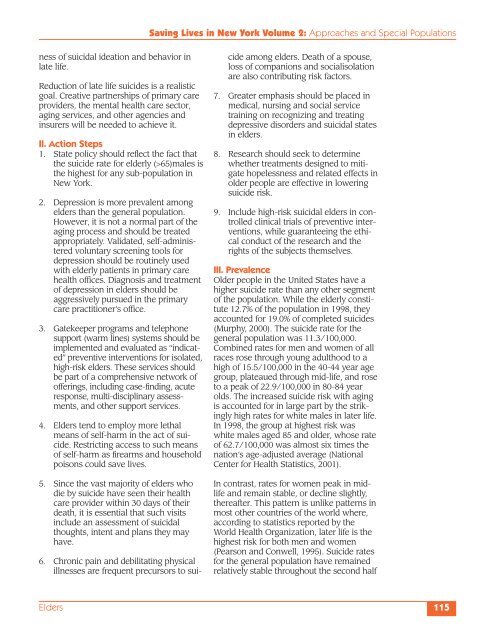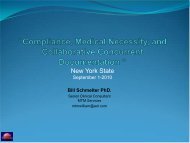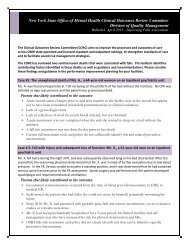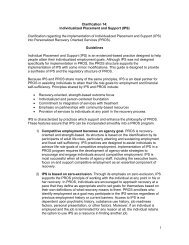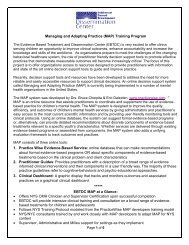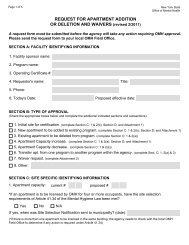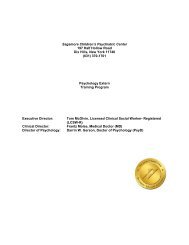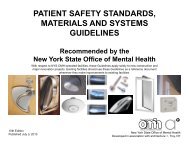Download - New York State Office of Mental Health
Download - New York State Office of Mental Health
Download - New York State Office of Mental Health
Create successful ePaper yourself
Turn your PDF publications into a flip-book with our unique Google optimized e-Paper software.
Saving Lives in <strong>New</strong> <strong>York</strong> Volume 2: Approaches and Special Populations<br />
ness <strong>of</strong> suicidal ideation and behavior in<br />
late life.<br />
Reduction <strong>of</strong> late life suicides is a realistic<br />
goal. Creative partnerships <strong>of</strong> primary care<br />
providers, the mental health care sector,<br />
aging services, and other agencies and<br />
insurers will be needed to achieve it.<br />
II. Action Steps<br />
1. <strong>State</strong> policy should reflect the fact that<br />
the suicide rate for elderly (>65)males is<br />
the highest for any sub-population in<br />
<strong>New</strong> <strong>York</strong>.<br />
2. Depression is more prevalent among<br />
elders than the general population.<br />
However, it is not a normal part <strong>of</strong> the<br />
aging process and should be treated<br />
appropriately. Validated, self-administered<br />
voluntary screening tools for<br />
depression should be routinely used<br />
with elderly patients in primary care<br />
health <strong>of</strong>fices. Diagnosis and treatment<br />
<strong>of</strong> depression in elders should be<br />
aggressively pursued in the primary<br />
care practitioner’s <strong>of</strong>fice.<br />
3. Gatekeeper programs and telephone<br />
support (warm lines) systems should be<br />
implemented and evaluated as “indicated”<br />
preventive interventions for isolated,<br />
high-risk elders. These services should<br />
be part <strong>of</strong> a comprehensive network <strong>of</strong><br />
<strong>of</strong>ferings, including case-finding, acute<br />
response, multi-disciplinary assessments,<br />
and other support services.<br />
4. Elders tend to employ more lethal<br />
means <strong>of</strong> self-harm in the act <strong>of</strong> suicide.<br />
Restricting access to such means<br />
<strong>of</strong> self-harm as firearms and household<br />
poisons could save lives.<br />
5. Since the vast majority <strong>of</strong> elders who<br />
die by suicide have seen their health<br />
care provider within 30 days <strong>of</strong> their<br />
death, it is essential that such visits<br />
include an assessment <strong>of</strong> suicidal<br />
thoughts, intent and plans they may<br />
have.<br />
6. Chronic pain and debilitating physical<br />
illnesses are frequent precursors to suicide<br />
among elders. Death <strong>of</strong> a spouse,<br />
loss <strong>of</strong> companions and socialisolation<br />
are also contributing risk factors.<br />
7. Greater emphasis should be placed in<br />
medical, nursing and social service<br />
training on recognizing and treating<br />
depressive disorders and suicidal states<br />
in elders.<br />
8. Research should seek to determine<br />
whether treatments designed to mitigate<br />
hopelessness and related effects in<br />
older people are effective in lowering<br />
suicide risk.<br />
9. Include high-risk suicidal elders in controlled<br />
clinical trials <strong>of</strong> preventive interventions,<br />
while guaranteeing the ethical<br />
conduct <strong>of</strong> the research and the<br />
rights <strong>of</strong> the subjects themselves.<br />
III. Prevalence<br />
Older people in the United <strong>State</strong>s have a<br />
higher suicide rate than any other segment<br />
<strong>of</strong> the population. While the elderly constitute<br />
12.7% <strong>of</strong> the population in 1998, they<br />
accounted for 19.0% <strong>of</strong> completed suicides<br />
(Murphy, 2000). The suicide rate for the<br />
general population was 11.3/100,000.<br />
Combined rates for men and women <strong>of</strong> all<br />
races rose through young adulthood to a<br />
high <strong>of</strong> 15.5/100,000 in the 40-44 year age<br />
group, plateaued through mid-life, and rose<br />
to a peak <strong>of</strong> 22.9/100,000 in 80-84 year<br />
olds. The increased suicide risk with aging<br />
is accounted for in large part by the strikingly<br />
high rates for white males in later life.<br />
In 1998, the group at highest risk was<br />
white males aged 85 and older, whose rate<br />
<strong>of</strong> 62.7/100,000 was almost six times the<br />
nation’s age-adjusted average (National<br />
Center for <strong>Health</strong> Statistics, 2001).<br />
In contrast, rates for women peak in midlife<br />
and remain stable, or decline slightly,<br />
thereafter. This pattern is unlike patterns in<br />
most other countries <strong>of</strong> the world where,<br />
according to statistics reported by the<br />
World <strong>Health</strong> Organization, later life is the<br />
highest risk for both men and women<br />
(Pearson and Conwell, 1995). Suicide rates<br />
for the general population have remained<br />
relatively stable throughout the second half<br />
Elders 115


